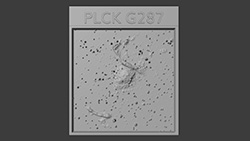CXC Home | Search | Help | Image Use Policy | Latest Images | Privacy | Accessibility | Glossary | Q&A
1
X-ray, Optical, and Radio Images of PLCK G287.0+32.9Credit: X-ray: NASA/CXC/SAO/K. Rajpurohit et al.; Optical: PanSTARRS; Radio: SARAO/MeerKAT; Image processing: NASA/CXC/SAO/N. Wolk
Astronomers have discovered the largest known cloud of energetic particles surrounding a galaxy cluster — spanning nearly 20 million light-years — called PLCK G287.0+32.9. This study reveals that the entire cluster is wrapped in a faint radio glow, nearly 20 times the diameter of the Milky Way. A cloud of energetic particles this large has never previously been observed in any galaxy cluster. The prior record holder, Abell 2255, spans roughly 16.3 million light-years. Thel images show X-rays from NASA’s Chandra X-ray Observatory, radio data from the MeerKAT radio telescope, and an optical image from PanSTARRS of the galaxy cluster PLCK G287.0+32.9. The massive cluster is located about 5 billion light-years from Earth.
2
3D Printable Files: of PLCK G287.0+32.9(3D Print Credit: NASA/CXC/A. Jubett, using software by Tactile Universe/N. Bonne & C. Krawczyk & Blender)
This tactile plate is a physical relief map based on the intensity of Chandra X-ray data along with optical data from PanSTARRS and radio data from MeerKAT, featuring a cloud of energetic particles surrounding a distant galaxy cluster. The galaxy cluster, known as PLCK G287, sits at the center of the plate; a collection of raised dots flecked with hundreds of similar specks. Surrounding the cluster is an X-ray cloud. This gradated cloud spans about five million light years.
Flanking the cloud at our upper right and lower left are wispy bands - giant shockwaves, relics detected by earlier studies of radio waves in the region. The band at our lower left is somewhat smaller and more clearly defined, while the shockwave at our upper right is larger, and abuts the central raised cloud.
Flanking the cloud at our upper right and lower left are wispy bands - giant shockwaves, relics detected by earlier studies of radio waves in the region. The band at our lower left is somewhat smaller and more clearly defined, while the shockwave at our upper right is larger, and abuts the central raised cloud.
Return to: Record-Breaking Cosmic Structure Discovered in Colossal Galaxy Cluster (June 9, 2025)







